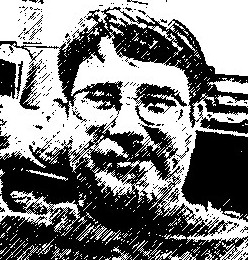The L1 lacks only paint and finish. It doesn't like the tight corners, but should run OK on a 15" minimum radius. I modified the drawbar connection by removing it from the locomotive and attaching it to the tender, it now hooks downward into the trailing truck to prevent contact between the loco's metal frame and the brass hook. I also hard-wired the tender to the LED light board in the locomotive, so it picks up on both sides from both locomotive and tender. The tender now needs a little weight to improve the contact, but this locomotive is as stall-free as the Bachmann Spectrum F-7's are.
The Atlas Mikado and Pacific have both received new gearmotors. They run well, but because they only pick up on one side of the locomotive chassis they can be a bit balky over turnouts. There doesn't seem to be any way to fix this, the original design had the tender picking up on one side and the loco on the other. The Bachmann tenders allow pickup on both sides, but since the Atlas frames still only pick up on one side of the locomotive a stall can occur if both tender trucks hit the same dead spot. Fortunately that doesn't happen often, and when it does a bit of track cleaning has so far taken care of it.
The Atlas locomotives run well with each other, but due to gearing differences they are both slower than the Kato mechanism under the L1. I haven't tried double-heading the Pacifics, but I will be surprised if the Model Power runs at the same speed as the remotored Atlas. The remotored Mikado isn't a very good puller when compared to the Kato, but that is no doubt due to the heavy pewter shell of the L1.
The Class J, by the way, has had it's drawbar shortened as well. Turns out that Bachmann supplied two holes to attach locomotive to tender, and it was at the furthest hole. The fix was to simply attach the locomotive to the closer of the two connecting holes.
So at this point the Atlas locomotives are complete and ready for service, and the L1 shell and tender will be painted as soon as I have time off from work to do them, along with the white metal bits on tender and loco mechanism. The Class J was ready to go from the time it came out of the box, but has now had it's minor quibble repaired. All of these locomotives have received Micro-Trains couplers on their tenders and all but the Class J has a Z scale Micro-Trains coupler in it's pilot. The fleet grows (but will soon contract by two train-set Northerns and two train-set Consolidations), so it's about time to give them a place to run.
I have ordered a new shed to be built and brought to the house, this will give me the much-needed storage space to de-clutter my "train room" and so give me the room I need to start building the new layout. First things first, the carpeting will come out and be replaced with a hard-surfaced floor of some sort. I have stick-on simulated wood strips that I will use if I have enough of them, and if not I'll see if I can find some more. If not once again, I'll look into some engineered wood floors.
I have also obligated myself to building a pair of Nn3 modules based on the East Broad Top Railroad's operations in Saltillo PA for the National Narrow Gauge Convention to be held next September in Hickory NC. To that end I have ordered the Fast Tracks Nn3 turnout kit for a #6 turnout, so I'll get to try my hand at building turnouts. If all goes well I'll get one for the standard gauge as well, and maybe I'll get crazy enough to get the ones for dual gauge. On top of that, I am trying to finish the dollhouse for the granddaughter before Christmas.
All in all I will be very busy for the next year.
Sunday, September 19, 2010
Subscribe to:
Post Comments (Atom)

No comments:
Post a Comment